Comet Hale–Bopp
was probably the most widely observed and imaged comet of the
20th century, and one of the brightest seen for many decades.
Hale–Bopp was discovered on July 23, 1995, separately by Alan Hale and Thomas Bopp prior to it becoming naked-eye visible on Earth.
Although predicting the maximum apparent brightness of new comets with any degree of certainty is difficult,
Hale–Bopp met or exceeded most predictions when it passed perihelion on April 1, 1997.
It was visible to the naked eye for a record 18 months, twice as long as the previous record holder, the Great Comet of 1811.
Accordingly, Hale–Bopp was dubbed the Great Comet of 1997.
Hale–Bopp was discovered on July 23, 1995, separately by Alan Hale and Thomas Bopp prior to it becoming naked-eye visible on Earth.
Although predicting the maximum apparent brightness of new comets with any degree of certainty is difficult,
Hale–Bopp met or exceeded most predictions when it passed perihelion on April 1, 1997.
It was visible to the naked eye for a record 18 months, twice as long as the previous record holder, the Great Comet of 1811.
Accordingly, Hale–Bopp was dubbed the Great Comet of 1997.
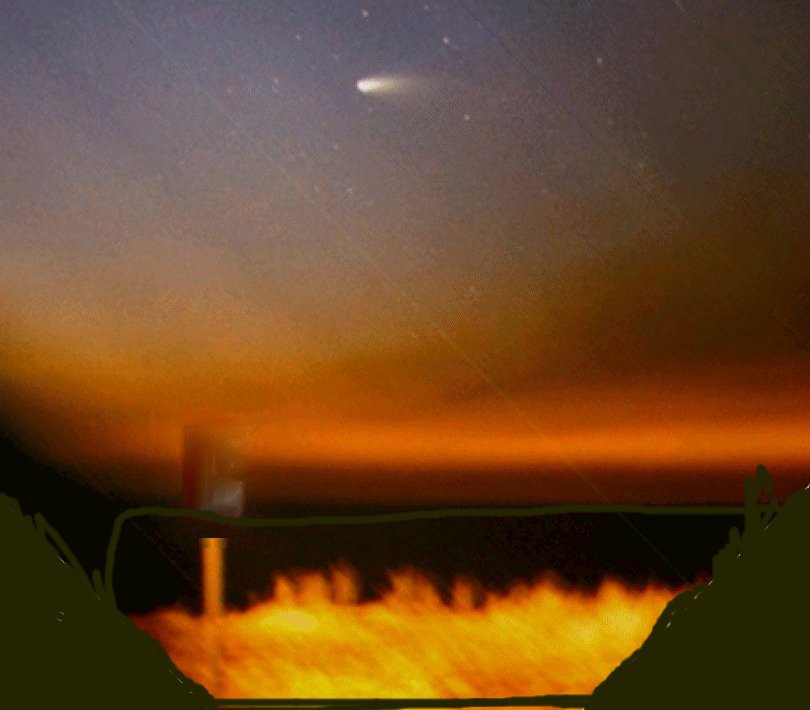
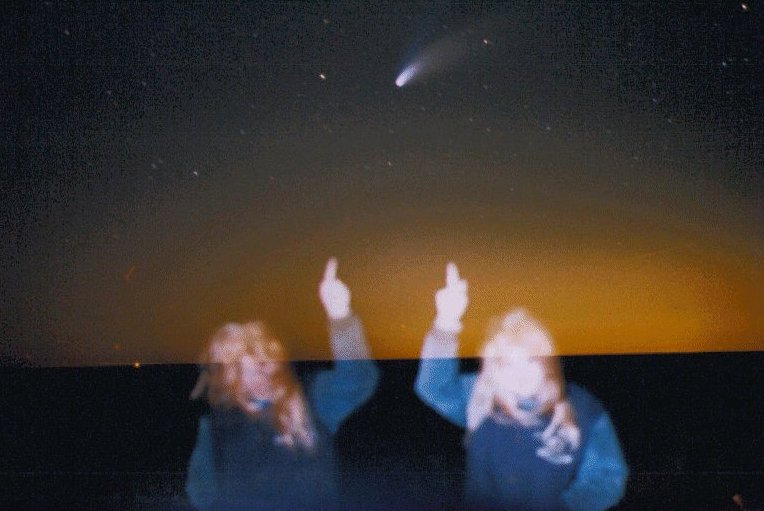
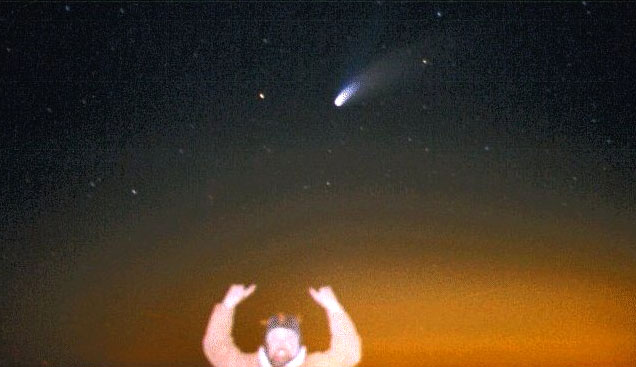
The comet was discovered independently on July 23, 1995, by two observers, Alan Hale and Thomas Bopp, both in the United States.
Hale had spent many hundreds of hours searching for comets without success, and was tracking known comets from his driveway in New Mexico when he chanced upon Hale–Bopp just after midnight.
The comet had an apparent magnitude of 10.5 and lay near the globular cluster M70 in the constellation of Sagittarius.
Hale first established that there was no other deep-sky object near M70, and then consulted a directory of known comets, finding that none were known to be in this area of the sky.
Once he had established that the object was moving relative to the background stars, he emailed the Central Bureau for Astronomical Telegrams, the clearing house for astronomical discoveries
Hale had spent many hundreds of hours searching for comets without success, and was tracking known comets from his driveway in New Mexico when he chanced upon Hale–Bopp just after midnight.
The comet had an apparent magnitude of 10.5 and lay near the globular cluster M70 in the constellation of Sagittarius.
Hale first established that there was no other deep-sky object near M70, and then consulted a directory of known comets, finding that none were known to be in this area of the sky.
Once he had established that the object was moving relative to the background stars, he emailed the Central Bureau for Astronomical Telegrams, the clearing house for astronomical discoveries
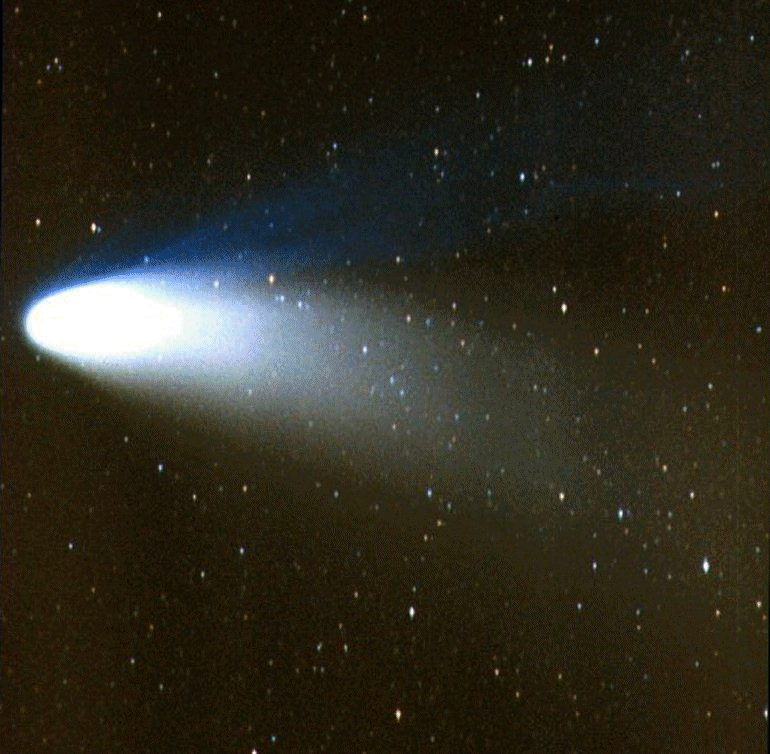
Bopp did not own a telescope. He was out with friends near Stanfield, Arizona, observing star clusters and galaxies when
he chanced across the comet while at the eyepiece of his friend's
telescope.
He realized he might have spotted something new when, like Hale, he checked his star maps to determine if any other deep-sky objects were known to be near M70, and found that there were none.
He alerted the Central Bureau for Astronomical Telegrams through a Western Union telegram.
Brian G. Marsden, who had run the bureau since 1968, laughed, "Nobody sends telegrams anymore. I mean, by the time that telegram got here, Alan Hale had already e-mailed us three times with updated coordinates."
The following morning, it was confirmed that this was a new comet, and it was given the designation C/1995 O1. The discovery was announced in International Astronomical Union circular 6187
Hale–Bopp's orbital position was calculated as 7.2 astronomical units (AU) from the Sun, placing it between Jupiter and Saturn and by far the greatest distance from Earth at which a comet had been discovered by amateurs.
Most comets at this distance are extremely faint, and show no discernible activity, but Hale–Bopp already had an observable coma.
An image taken at the Anglo-Australian Telescope in 1993 was found to show the then-unnoticed comet some 13 AU from the Sun, a distance at which most comets are essentially unobservable.
(Halley's Comet was more than 100 times fainter at the same distance from the Sun.)
Analysis indicated later that its comet nucleus was 60±20 kilometres in diameter, approximately six times the size of Halley.
Its great distance and surprising activity indicated that comet Hale–Bopp might become very bright indeed when it reached perihelion in 1997.
However, comet scientists were wary – comets can be extremely unpredictable, and many have large outbursts at great distance only to diminish in brightness later.
Comet Kohoutek in 1973 had been touted as a 'comet of the century' and turned out to be unspectacular, as did Halley's Comet, 1P in 1986..
Hale–Bopp became visible to the naked eye in May 1996, and although its rate of brightening slowed considerably during the latter half of that year,
Scientists were still cautiously optimistic that it would become very bright.
It was too closely aligned with the Sun to be observable during December 1996, but when it reappeared in January 1997
it was already bright enough to be seen by anyone who looked for it, even from large cities with light-polluted skies
He realized he might have spotted something new when, like Hale, he checked his star maps to determine if any other deep-sky objects were known to be near M70, and found that there were none.
He alerted the Central Bureau for Astronomical Telegrams through a Western Union telegram.
Brian G. Marsden, who had run the bureau since 1968, laughed, "Nobody sends telegrams anymore. I mean, by the time that telegram got here, Alan Hale had already e-mailed us three times with updated coordinates."
The following morning, it was confirmed that this was a new comet, and it was given the designation C/1995 O1. The discovery was announced in International Astronomical Union circular 6187
Hale–Bopp's orbital position was calculated as 7.2 astronomical units (AU) from the Sun, placing it between Jupiter and Saturn and by far the greatest distance from Earth at which a comet had been discovered by amateurs.
Most comets at this distance are extremely faint, and show no discernible activity, but Hale–Bopp already had an observable coma.
An image taken at the Anglo-Australian Telescope in 1993 was found to show the then-unnoticed comet some 13 AU from the Sun, a distance at which most comets are essentially unobservable.
(Halley's Comet was more than 100 times fainter at the same distance from the Sun.)
Analysis indicated later that its comet nucleus was 60±20 kilometres in diameter, approximately six times the size of Halley.
Its great distance and surprising activity indicated that comet Hale–Bopp might become very bright indeed when it reached perihelion in 1997.
However, comet scientists were wary – comets can be extremely unpredictable, and many have large outbursts at great distance only to diminish in brightness later.
Comet Kohoutek in 1973 had been touted as a 'comet of the century' and turned out to be unspectacular, as did Halley's Comet, 1P in 1986..
Hale–Bopp became visible to the naked eye in May 1996, and although its rate of brightening slowed considerably during the latter half of that year,
Scientists were still cautiously optimistic that it would become very bright.
It was too closely aligned with the Sun to be observable during December 1996, but when it reappeared in January 1997
it was already bright enough to be seen by anyone who looked for it, even from large cities with light-polluted skies
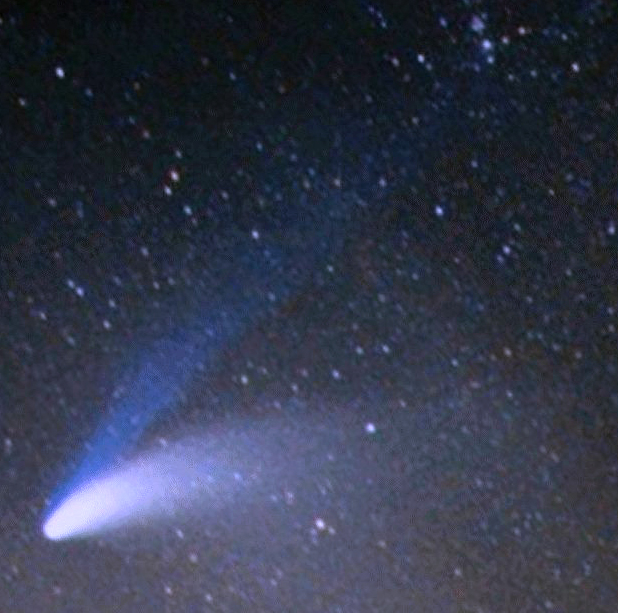
The Internet was
a growing phenomenon at the time, and numerous websites that tracked
the comet's progress and provided daily images from around the world
became extremely popular.
The Internet played a large role in encouraging the unprecedented public interest in comet Hale–Bopp
As the comet approached the Sun, it continued to brighten, shining at 2nd magnitude in February, and showing a growing pair of tails,
The blue gas tail pointing straight away from the Sun and the yellowish dust tail curving away along its orbit.
On March 9, a solar eclipse in China, Mongolia and eastern Siberia allowed observers there to see the comet in the daytime.
Hale–Bopp had its closest approach to Earth on March 22, 1997, at a distance of 1.315 AU
As it passed perihelion on April 1, 1997, the comet developed into a spectacular sight.
It shone brighter than any star in the sky except Sirius, and its dust tail stretched 40–45 degrees across the sky.
The comet was visible well before the sky got fully dark each night, and while many great comets are very close to the Sun as they pass perihelion, comet Hale–Bopp was visible all night to northern hemisphere observers.
The Internet played a large role in encouraging the unprecedented public interest in comet Hale–Bopp
As the comet approached the Sun, it continued to brighten, shining at 2nd magnitude in February, and showing a growing pair of tails,
The blue gas tail pointing straight away from the Sun and the yellowish dust tail curving away along its orbit.
On March 9, a solar eclipse in China, Mongolia and eastern Siberia allowed observers there to see the comet in the daytime.
Hale–Bopp had its closest approach to Earth on March 22, 1997, at a distance of 1.315 AU
As it passed perihelion on April 1, 1997, the comet developed into a spectacular sight.
It shone brighter than any star in the sky except Sirius, and its dust tail stretched 40–45 degrees across the sky.
The comet was visible well before the sky got fully dark each night, and while many great comets are very close to the Sun as they pass perihelion, comet Hale–Bopp was visible all night to northern hemisphere observers.
On
a trip to West Virgina I spotted Comet Hale Bopp in the trees with
binoculars and was able to show it to relatives even before it got dark
outside in the evening twilight.
in the 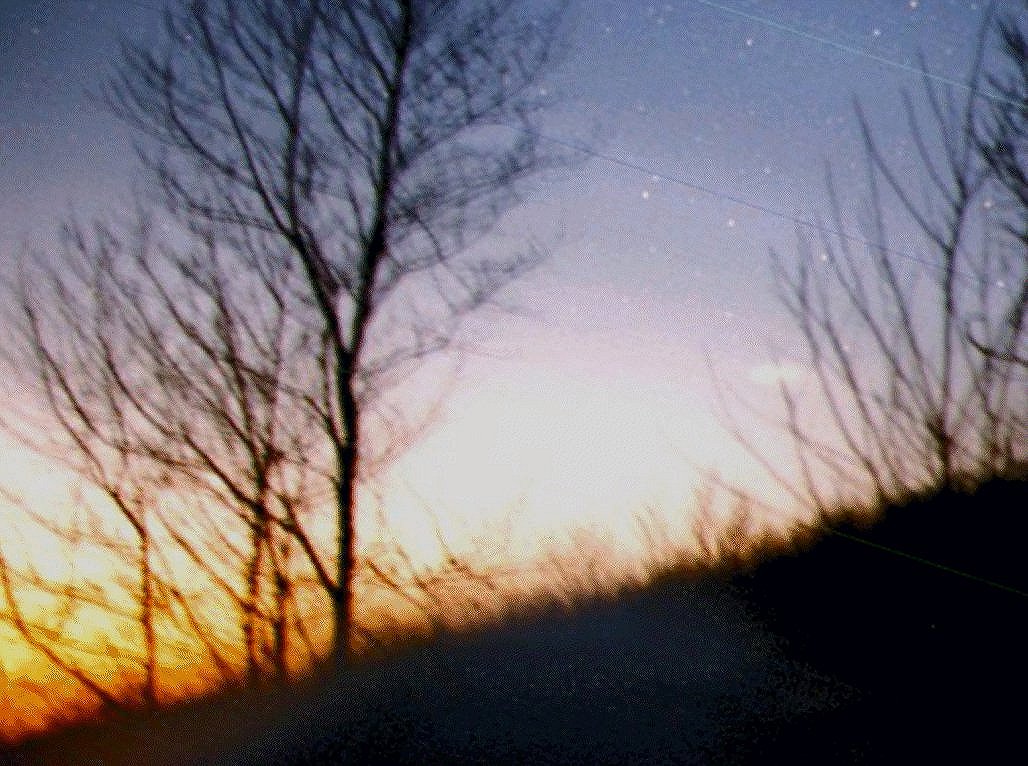
In addition to the size and brighness, the dual tails made this comet rather spectacular.
Usually the blue ion tail is significantly dimmer than the dust tail, but this apparition was different.
The blue ion tail was easily visible to the naked eye.

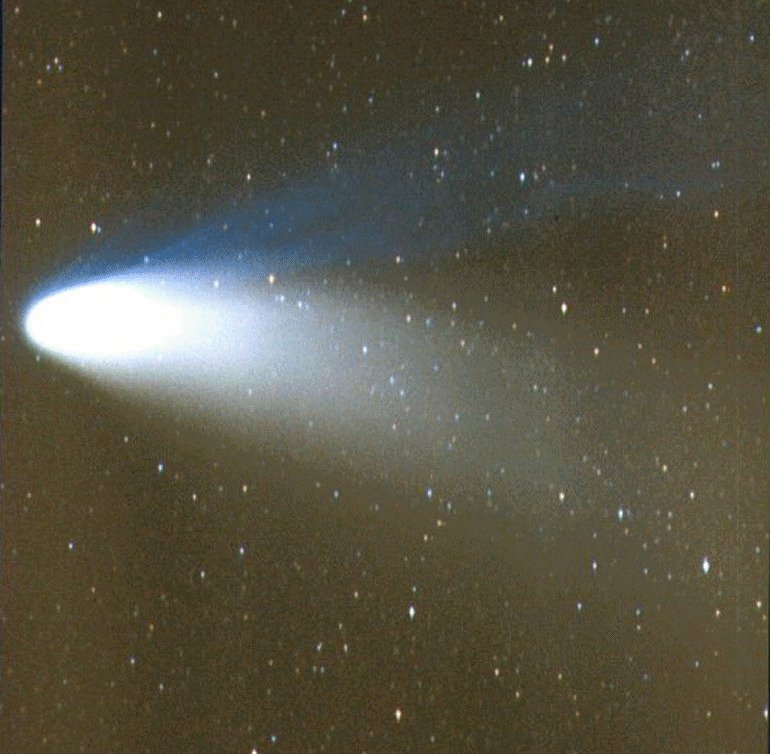

In addition to the size and brighness, the dual tails made this comet rather spectacular.
Usually the blue ion tail is significantly dimmer than the dust tail, but this apparition was different.
The blue ion tail was easily visible to the naked eye.

